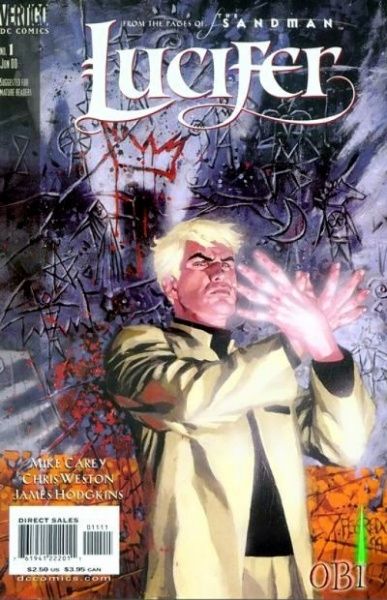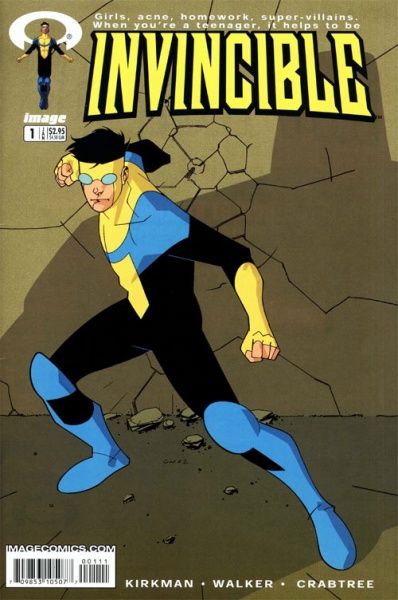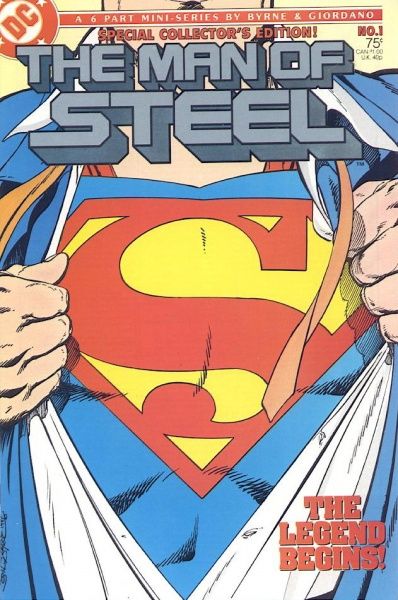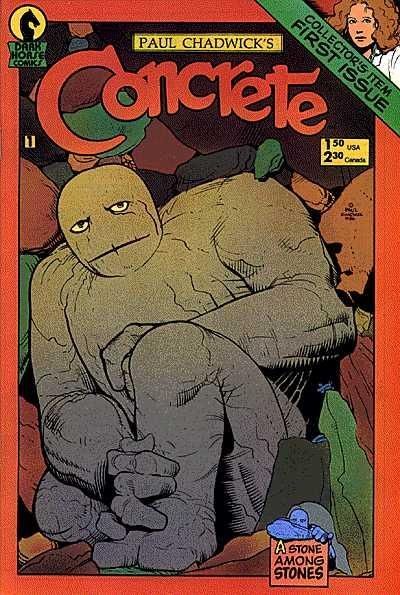Here's the next five runs in our vote of almost 700 ballots! Remember, feel free to share your reasons for why you picked your top run. Just e-mail me!
Otherwise, enjoy!
80. Mike Carey, Peter Gross and Ryan Kelly's Lucifer - 114 points (3 first place votes)
The Sandman Presents: Lucifer #1-3, Lucifer #1-75
I debated whether to include Gross and Kelly, but I figured, eh, they did enough of the seventy-five issues to count.
In any event, in this acclaimed sequel to Sandman, Mike Carey had Lucifer be his typical self. He was running a piano bar in Los Angeles, with his female consort, Mazikeen, and just when he thought he was out, he got pulled back into the devil game, and the rest of the series basically depicted the various mischief Lucifer finds himself involved with, particularly with the creation of an alternate universe to the one created by Yahweh.
Mixed in the run, similar to Neil Gaiman's Sandman, were a series of one-off stories depicting various humans and how they get caught up in the various situations.
Gross and Kelly delivered strong, character-infused artwork, with a nice eye for horror.
What was particularly striking about Carey's work is how he slowly introduced, and then developed, a large supporting cast, until we finally reach the final stories of the run, where it all comes together quite nicely.
This is really the only sequel to Sandman that truly held a candle to the original.
79. Robert Kirkman's Invincible - 115 points (1 first place vote)
Invincible #1-current (#49)
Robert Kirkman and Cory Walker first gained Image's attention with their mini-series about Erik Larsen's SuperPatriot character.
Soon, Image decided to buck industry trends and attempt to launch a brand new, old school superhero line of comics.
Invincible is the only comic left from that line (although Phil Hester is bringing his Firebreather comic back!!). It has managed to draw attention due to Kirkman's interesting blend of Silver Age-style stories with a more modern feel. It is like a mixture of Ditko/Lee Spider-Man and Superman, as Invicible is a young teen whose father is the revered superhero, Omni-Man, and Mark learns that he has superpowers as well!!
Taking the name Invincible, Mark begins his training as a superhero. Soon after, though, Kirkman pulls out a really clever twist (I won't spoil it) that totally changes the way the comic is viewed.
The comic is a fun action-filled comic book that has a great deal of good-natured humor, although Kirkman is never afraid to bring drama into the book at times - characters ARE killed, and there ARE effects to actions.
At the heart of the comic, though, Invincible is about a young man coming into his own as a superhero. It's a lot like Static, which also was a sort of modern take on Spider-Man.
Original artist Cory Walker left soon into the book's run, but Kirkman was lucky to land replacement artist, Ryan Ottley, who has been an excellent addition, and has remained the artist ever since.
The book is nearing its 50th issue.
78. Joe Casey's Wildcats - 117 points (1 first place vote)
Wildcats Vol. 2 #8-28, Wildcats 3.0 #1-24
Joe Casey actually began work on Wildcats a little earlier than #8, but that was mostly finishing the plots that Scott Lobdell had left behind. #8 started the beginning of Casey's run on Wildcats with artist Sean Phillips, and it was yet another example of a writer taking over a floundering series and using the freedom given to basically do whatever s/he wanted.
In his run, Casey spotlighted Spartan, the android member of the Wildcats who was asked by the immortal Emp (the little tiny guy who was the head of Wildcats, who went by the human name of Marlowe) to kill Emp. Spartan did so, and thereby took control of Emp's company, Halo, Inc.
The rest of Volume One dealt with a serial killer who was hunting down relatives of Emps. The Wildcats stopped him, but not before two of the team members were crippled. By this time, it was clear that Casey's plan was interesting enough to be given its own run rather than finishing someone else's, so after a few short arcs wrapping up loose plots, the book relaunched as Wildcats 3.0, which was about Spartan (now calling himself Jake Marlowe) using the Halo, Inc. to save the world through the power of a corporation.
It was truly innovative stuff, and Grifter even still had a role in the book, as Spartan's troubleshooter.
Dustin Nguyen picked up from Sean Phillips (with Phillips going to work on Sleeper) on the art.
It was a brilliant book, but sadly only lasted two years.
77. John Byrne's Superman - 119 points (1 first place vote)
Man of Steel #1-6, Superman Vol. 2 #1-22, Action Comics #584-600, Adventures of Superman #436-442, 444, The World of Krypton #1-4, The World of Metropolis #1-4, and The World of Smallville #1-4.
In a bold move for the time, DC hired popular comic creator, John Byrne, to reboot Superman in 1986.
Byrne made a number of changes (although, notably, he also did not change a LOT of the comic - there certainly were more similarities to Pre-Byrne Superman comics in Byrne's Superman than dissimilarities), including reducing Superman's power level to one closer to the 1940s Superman, making Clark Kent more of an important part of the book (including a revamped origin where Clark was more popular as a teen), eliminating Superman ever operating as Superboy (as Clark gained his powers in his late teens), making Superman the sole survivor of Krypton, making Krypton a cold, heartless planet and basically having all the various Superman villains be reintroduced by Byrne or Marv Wolfman (who began the reboot with Byrne, but soon Byrne took over writing his comic, as well).
The reboot was a smashing sales success, but Byrne presumably took some issue with some things DC apparently promised him, as he felt he was undercut by DC publicly as soon as he began the reboot, as though they were hedging their bets on the reboot publicly, so as to not offend the older fans (for instance, the Pre-Byrne Superman was still the one that DC licensed).
In either event, Byrne left the book after about two years, although he left with incoming writer, Roger Stern (who, along with Jerry Ordway, took over Byrne's books), a fairly detailed storyline that took the books to about the three year mark.
76. Paul Chadwick's Concrete - 120 points (4 first place votes)
Dark Horse Presents #1-6, 8, 10, 12, 14, 16, 18, 20, 22, 28 and 32, Concrete #1-10, then a ton of Concrete one-shots and mini-series (Dark Horse has collected them all)
At first glimpse, the concept of Concrete is QUITE familiar to most comic fans, especially Fantastic Four fans.
This fellow, Ron Lithgow, had his mind transported by aliens into this weird body that looked like it was made out of, well, Concrete. Ron then had to deal with the fact that he was trapped in the body of a monster.
While it is quite reminiscent of Ben Grimm's dilemma as the Thing, what stood out about Concrete was how beautifully Chadwick handled all the inherent drama in the situation. Most folks already knew that Chadwick was a talented artist, but the way he handled the characters in Concrete was surprising (in a really good way).
While Concrete used his new body to go on a number of adventures that never would have been possible in his old body, most of the book was real slice-of-life stuff. Really quiet, human stories.
Concrete was there at the very start of Dark Horse Comics, appearing in the very first comic Dark Horse published, Dark Horse Comics, in 1986, and Concrete was one of the first Dark Horse characters to be given his own series.
Concrete had a lot of stories about environmentalism, including a special issue just for Earth Day!!






